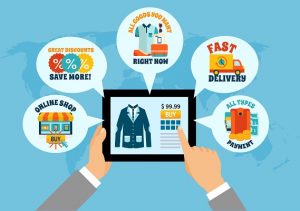Mobility: A Key Strategic Initiative for both Consumer and B2B-facing Companies
Mobility is the midst of an unprecedented boom phase, as more and more enterprises seek to leverage the advantages it offers in terms of remaining connected anytime and anywhere, unmatched convenience, improved efficiency, and more. Most enterprises now regard investments in mobility as a key cutting-edge initiative, and this holds true for both B2C and B2B enterprises.
However, amidst the mobility boom, many enterprises falter on the implementation front. About two out of every three IT leaders list mobility as their top priority in 2016, and there is no dearth of mobile apps in enterprises. However, only 48% of enterprises have a formal mobile strategy in place. Enterprises lose out on the full benefits of mobility without a coherent strategy. Many organizations are still in early stages of their mobile strategy development, and remain overwhelmed with technology standards, data governance, and security challenges, leave alone application development and user experience.
The Elements of a Mobility Strategy
Mobility driven solutions speeds up processes, makes systems more efficient and transparent, and enhances employee engagement. Above all, mobility has the potential to power long-term growth, and transform businesses. However, it requires a coherent mobile strategy to effect a successful digital transformation.
The first wave of mobility boosted efficiency in a big way. Mobility is now on the cusp of a new wave, where enterprises are increasingly leveraging mobile devices to innovate, to unlock business value, and power disruptive change.
-
Mobility 1.0: Migrating Existing Digital Assets to Mobile
The first wave of the mobility revolution involves migrating or extending existing functions and apps to mobility. This includes mobile-optimizing websites, and launching micro apps for specific purposes, such as approvals, expense reporting, and time tracking.
-
Mobility 2.0: Transform Existing Processes
The second wave of mobility revolution involves enhancing capabilities of existing apps, by infusing it with new functionality that fully leverages the possibilities offered by mobility. An app could, for instance, offer functionality based on smartphone features such as bar-code scanning, image scanning, and location data. Retailers could improve in-store customer service by offering real-time information and discounts to customers, based on GPS or location data. Temperature and vibration data, derived from sensors, could minimize downtime in processing plants.
Mobile enabled processes are on the whole simpler, faster, convenient, and accurate. For instance, a mobile expense submitting process, which auto-populate forms and allow capturing receipts digitally using the smartphone camera, is much quicker and easier than the cumbersome paperwork and productivity killing tasks otherwise required for the process.
-
Mobility 3.0: New Business Models
The biggest benefits of mobility realize by combining technology with process transformation.
New design paradigms based on touch and voice navigation, combined with the portability mobility infuses dynamism into business processes, and unlocks many possibilities not viable before.
Integrating mobility and analytics enable a shift from standardized to personalized, which improves engagement and customer satisfaction, and also allows enterprises to conserve resources, without using it for prospects and customers who do not need it, or are unlikely to be impressed by it. Companies could also offer new contextual services, integrating location, device type, transaction history, social media sentiment, and other relevant information.
The success of any business in today’s highly competitive world requires a proactive approach, rather than dealing with events reactively. Proactiveness requires being driven by insights, and the ability to remain connected with the stakeholders and the ecosystem, in real time. Mobile devices facilitate the collaboration and cooperation required to apply proactive measures.
Examples of how mobility can transform business models are aplenty:
- Tech player Square allows consumers and businesses to accept credit card payments, by integrating a tiny device on the headphone jack of a mobile device, eliminating the need for a swiping machine or a financial intermediary
- Commuters in Spain and Germany pay for their travel tickets through contactless smart cards and payment systems, powered by NFC-enabled smartphones. Widespread adoption of the concept can eliminate cash tills and ticket counters in a big way.
- Mobility inspired augmented reality solutions revolutionize the way their field forces access parts and repair documentation. What took several individuals with specialized training days to complete now requires just a few hours, and just a single ordinary repair technician with general training, and who knows how to use a smartphone app. A three-dimensional augmented reality (AR) app guides the technician step-by-step through the repair, identifying all the parts and seeing exactly what actions to take via animated video clips.
The Wider Ecosystem
A successful mobile strategy cannot be executed in isolation. It is rather part of a wider digital strategy that includes social, analytics, and cloud, among other things. The social-mobility-analytics-cloud (SMAC) stack enables organizations to embark on a digital revolution, offering ubiquitous connectivity and new ways of interacting with their ecosystem. The cloud especially complements the mobile strategy perfectly. Apart from cloud-resident SaaS (Software as a Service) applications that deliver mobile applications, the cloud offers storage solutions, testing environments for cloud-based enterprise app development, mobile application middle-ware and development tools, and also Analytics as a Service (AaaS) capabilities.
Using mobility as part of a toolkit, to reinvent internal processes and transform business models works wonders as long as the harbingers of change know what they are doing. The best approach is to partner with an experienced and established solutions provider. We bring to the table not just skills and talent, but also the ability to gain from our experience of having executed several successful mobility projects, cutting across sectors. We not only lend our expertise on designing highly efficient systems, but also help you guide decisions around the essential architecture, standards, security, and governance decisions.
Stay up to date on what's new

Recommended Posts

25 Aug 2020
Why It’s Time to Embrace Cloud and Mobility Trends To Recession-Proof Your Business?
Cloud and Mobility: The two pillars to recession-proof your business Introduction How Does the Recovery Shape of The Coronavirus Recession Look? What is a recession-proof business? What can business……

22 Jun 2017
How Business is Adapting to the Next level of Mobility in The Hyper-Connected World
Employees and other key stakeholders of a business now expect seamless, 'always-on' mobile connectivity from the device of their choice. Work processes are now built around mobility, and a throwback……

19 May 2017 Retail
Mobile Connectivity Issues: The Hidden Danger Subverting Enterprise Mobility
The need for remote connectivity is growing day by day, as the ranks of the mobile workforce swell. While enterprises are busy rolling out mobile apps to facilitate the mobile……

08 May 2017
Native Apps vs Web Apps: Choosing the Best For Your Brand
Mobility is growing at an exponential pace and mobility apps are the flavor of the season. However, it is still important to get the development right, to reap the benefits……
Featured Blogs
Stay up to date on
what's new













